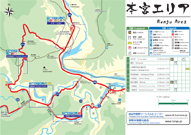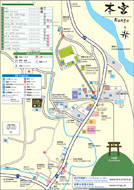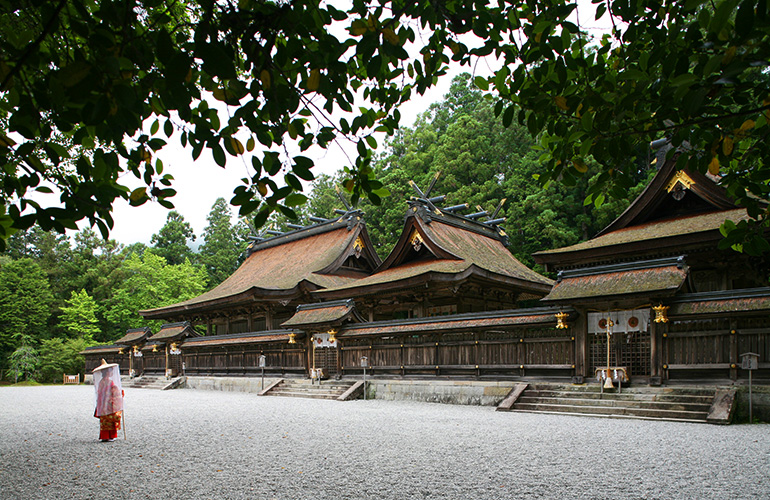
Kumano Hongu Taisha Grand Shrine
A long stone staircase leads to the sacred grounds of the Kumano Hongu Taisha located on a ridge surrounded by giant cedar and cypress trees. It is one of the Kumano Sanzan, three grand shrines of Kumano, and head shrine of over 3,000 Kumano shrines across Japan.
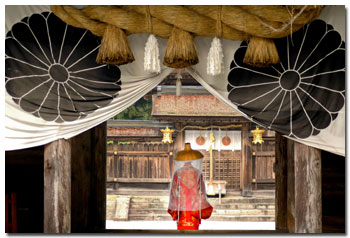
Shrine Grounds
Price: Free
Shrine Office
Hours: 8:00~17:00
Homotsuden Treasure Hall
Price: Adult 300 yen, 12~15 100 yen, 11 and under free
Hours: 9:00~16:00
Oyunohara
Kumano Hongu Taisha was originally located at Oyunohara, a sandbank at the confluence of the Kumano and Otonashi Rivers. Legend has it that the Kumano deities, in the form of three moons, descended into the branches of a giant oak tree in this clearing. All of the Kumano Kodo pilgrimage routes lead to this sacred site.
In 1889 a severe flood destroyed many of the shrine buildings. The salvaged remains of the pavilions were rebuilt at their present site. You can still see the expansive, raised earthen platform where the pavilions once stood. Of the original five main pavilions only three were rebuilt. Four deities were moved there and the other eight are still enshrined here in two stone monuments.
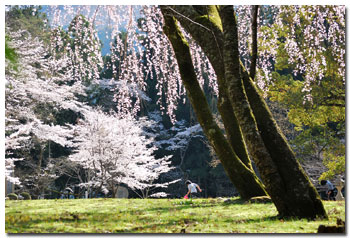
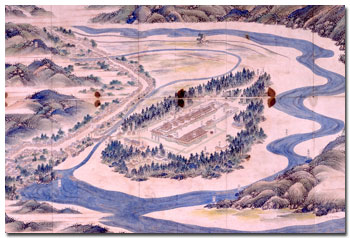
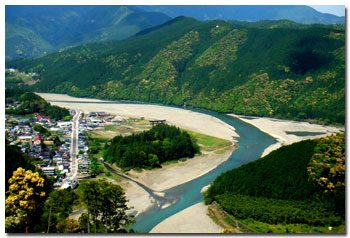
The entrance to Oyunohara is marked by the largest Torii shrine gate in the world (33.9 meters tall and 42 meters wide). It’s a formalized gateway that designates the entrance to a sacred area. It signifies the division of the secular and the spiritual worlds. This Torii is called Otorii, O means “big”. It was erected in the year 2000 and is made of steel.
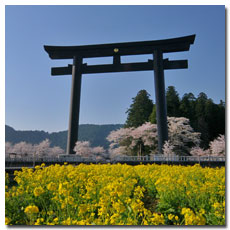
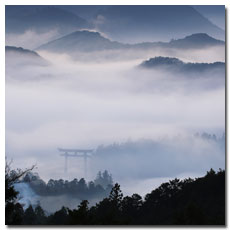
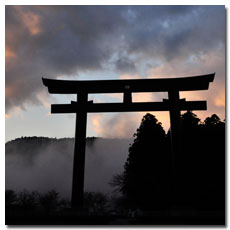
The Otorii weighs 172 tons and took about 6 months to make and 6 months to assemble. It is lit up during special occasions and festivals, such as during the Kumano Hongu Taisha Spring Festival, the Yata-no-Hi Matsuri Fire Festival, and during the New Year holiday.
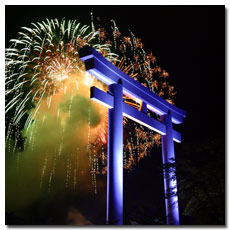
Festivals
Kumano Hongu Taisha Spring Festival
The annual spring festival held April 13th to 15th every year is not only a quintessential festival of Kumano but also intimately associated with the pilgrimage to Kumano and the Kumano Kodo pilgrimage route.
On April 13th fathers and their young sons purify themselves in the sacred waters of Yunomine Onsen before walking over the Dainichi-goe section of the Kumano Kodo pilgrimage route to Oyunohara wearing traditional costumes. The young boys have the character for big on their forehead and are forbidden to touch the ground.
On April 15th the Kumano Deities are invoked to temporarily take up residence in a portable mikoshi shrine and returned to their original site of descend, Oyunohara. The atmosphere is serene, traditional, authentic and inspiring. Yamabushi mountain ascetics also perform a fire ritual. If you are interested in experiencing a traditional festival in the quiet, spiritual mountains of Kumano this is the festival for you.
More Kumano Hongu Taisha Spring Festival >>
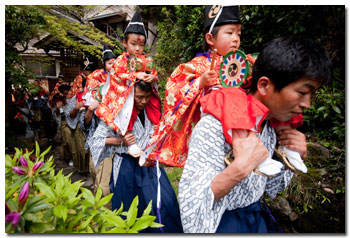
Yata-no-Hi Matsuri Fire Festival
Festival taking place on the last Saturday of August, in Oyunohara (Hongu-cho), in honor of the Yatagarasu crow. This fire festival includes the parading of a fire mikoshi, a Taiko drum show, dancing, and fireworks.
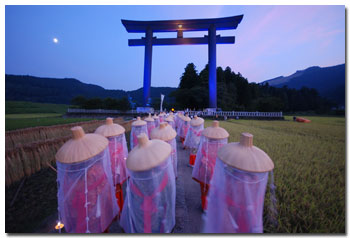
Shrine Pavilion Architecture
Over 900 years ago a pilgrim wrote of a massive shrine grounds including five main pavilions enshrining 12 deities. There was also a stage to perform music, dance and Noh dramas as religious offerings. Numerous other small temples and shrines could be found surrounding the main buildings.
Over the centuries the pavilions were partially destroyed by periodic fires and flooding, but always faithfully rebuilt to their original state. The last fire was in 1776 and the buildings rebuilt again in 1803. The first drawing of the shrine grounds from over 800 years ago and the reconstruction that took place in 1803 are almost exactly identical. After the flood of 1889, the shrine pavilions were meticulously rebuilt at their present location.
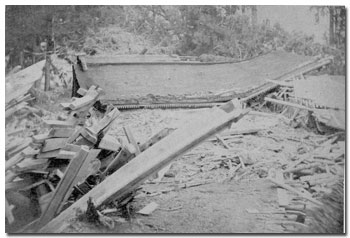
The austere pavilions of the Kumano Hongu Taisha are an outstanding example of Japanese Shrine architecture. The use of natural unfinished materials allows it to blend effortlessly into the natural environment, as if it has grown from Kumano’s sacred soils. There are few nails used in the construction instead relying on intricate joint work.
Notice how the thick roof gracefully sweeps forward extending over the stairs and the area in front of the shrine. It is made entirely of Hinoki, or Japanese cypress bark. Some of the raw materials come from the trees in the surrounding shrine grove as well as from around the Tsukimigaoka-jinja shrine on the Dainichi-goe section of the Kumano Kodo Pilgrimage route that connects Hongu and Yunomine Onsen. It is replaced every 40~50 years. These restoration projects are expensive and labor-intensive. It is difficult to acquire the traditional building materials; furthermore, the number of skilled craftsmen has drastically diminished with the prevalence of modern-day construction techniques.
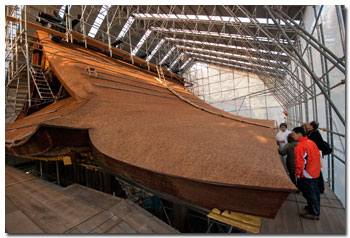
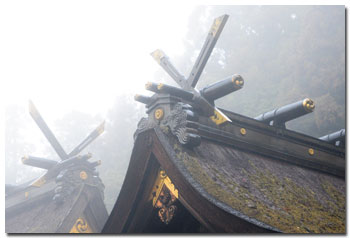
The bronze ornaments on the rooftop are characteristic features of shrine architecture. They are now symbolic of the sacred nature of the structure but originally they derived from functional construction techniques and markers of status. The x-shaped crosspieces that pierce the sky are called Chigi and the log-like beams that are laid horizontally along and perpendicular to the ridgeline are called Katsuogi. They add a dramatic highlight to the roofline.
Unique to the Kumano Hongu Taisha is the space or corridor under the verandas of the pavilions. You can see them if you look through the fence. There used to be no fence around the structures so pilgrims and ascetics would use this tiny refuge for meditation, prayer, sutra copying, austere rites and even sleeping quarters. Devotees would receive oracles and commune with the Kumano Deities in this sacred asylum. In fact, this is where Saint Ippen Shonin was enlightened. The Kumano Hongu Taisha is a mixture between Kasuga and Taisha styles but because of this sacred corridor, it has also been referred to as the Kumano style.
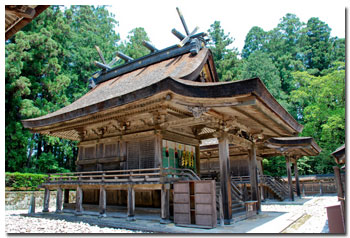
Kumano Hongu Taisha Access
Busses run daily to Kumano Hongu Taisha from JR Kii-Tanabe Station, Shirahama, Shingu and Gojo.
● ~2 hours by bus from Kii-Tanabe Station (bus timetable 1)
● ~2 hour 10 minutes by bus from Shirahama (bus timetable 1)
● ~1 hour 20 minutes by bus from Shingu Station (bus timetable 3)
● ~4 hours by bus from Gojo (bus timetable 4)
※ The nearest bus time “Hongu-Taisha-mae 本宮大社前”.

